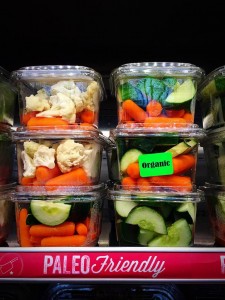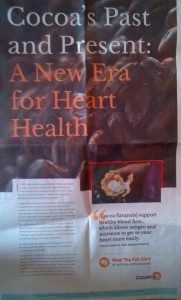Five more industry-funded studies with expected results. Score 70:5
A reminder that since mid-March I’ve been collecting studies funding by food companies. These greatly tend to produce results favorable to the sponsor’s interests. Today’s group makes 70. I have an ongoing call out for sponsored studies that don’t. So far I’ve found 5 . If you run across either kind, please send.
Breakfasts Higher in Protein Increase Postprandial Energy Expenditure, Increase Fat Oxidation, and Reduce Hunger in Overweight Children from 8 to 12 Years of Age. Jamie I Baum, Michelle Gray, and Ashley Binns. J Nutr 2015;145:2229–35.
- Conclusion: This study indicates that breakfast macronutrient composition affects postprandial responses in both NW [normal weight] and OW [overweight] children. A PRO [high protein breakfast] increases postprandial EE [energy expenditure] and fat oxidation, reduces hunger, and increases satiety when compared with a carbohydrate-based breakfast.
- Funding: Supported by a grant from the Egg Nutrition Center/American Egg Board, Chicago, IL.
- Added note: this one is a repeat of one posted earlier.
Dietary Whey and Casein Differentially Affect Energy Balance, Gut Hormones, Glucose Metabolism, and Taste Preference in Diet-Induced Obese Rats. Adel Pezeshki, Andrew Fahim, and Prasanth K Chelikani. J. Nutr. 2015; 145:2236-2244 doi:10.3945/jn.115.213843
- Conclusion: Together, these data demonstrate that in obese rats, whey, casein, and their combination improve energy balance through differential effects on food intake, taste preference, energy expenditure, glucose tolerance, and gut hormone secretion.
- Funding: Supported by operating grants from the Alberta Livestock and Meat Agency, Alberta Innovates Bio-Solutions, Alberta Milk…Whey protein isolate for this study was donated by Agropur Dairy Cooperative (Canada).
Consumption of Yogurt, Low-Fat Milk, and Other Low-Fat Dairy Products Is Associated with Lower Risk of Metabolic Syndrome Incidence in an Elderly Mediterranean Population. Nancy Babio, Nerea Becerra-Tomás, Miguel Ángel Martínez-González, Dolores Corella, Ramon Estruch, Emilio Ros, Carmen Sayón-Orea, Montserrat Fitó, Lluís Serra-Majem, Fernando Arós, Rosa M Lamuela-Raventós, José Lapetra, Enrique Gómez-Gracia, Miguel Fiol, Andrés Díaz-López, José V Sorlí, J Alfredo Martínez, Jordi Salas-Salvadó, on behalf of the PREDIMED Investigators. J. Nutr. 2015; 145:2308-2316 doi:10.3945/jn.115.214593
- Conclusions: Higher consumption of low-fat dairy products, yogurt (total, low-fat, and whole-fat yogurt) and low-fat milk was associated with a reduced risk of MetS [metabolic syndrome] in individuals at high cardiovascular disease risk from a Mediterranean population. Conversely, higher consumption of cheese was related to a higher risk of MetS.
- Funding: This study was funded in part by the Spanish Ministry of Health…Thematic Network…the European Regional Development Fund, and the Catalan Nutrition Center of the Institute of Catalan Studies.
- Author disclosures: N Babio received consulting fees from Danone. R Estruch served on the board of, and received lecture fees from, the Research Foundation on Wine and Nutrition…E Ros served on the board of, and received travel support and grant support through his institution from the California Walnut Commission; served on the board of the Flora Foundation (Unilever)… L Serra-Majem is a member of the Scientific Advisory Board and received consulting fees and grant support from the European Hydratation Institute, received lecture fees from the International Nut Council, and received travel support from Nestle. F Arós received payment for the development of educational presentations from Menarini and Astra Zeneca. RM Lamuela-Raventós serves on the board of, and received lecture fees from, the Research Foundation on Wine and Nutrition; received lecture fees from Cerveceros de España; and received lecture fees and travel support from PepsiCo. J Salas-Salvadó served on the board of, and received grant support through his institution from the International Nut and Dried Fruit Council; received consulting fees from Danone; and received grant support through his institution from Eroski and Nestlé. N Becerra-Tomás, MÁ Martínez-González, D Corella, C Sayón-Orea, M Fitó, J Lapetra, E Gómez-Gracia, M Fiol, A Díaz-López, JV Sorlí, and JA Martínez, no conflicts of interest.
- Comment: This study was funded by independent agencies but the authors report many financial connections to food companies.
Type and amount of dietary protein in the treatment of metabolic syndrome: a randomized controlled trial. Alison M Hill, Kristina A Harris Jackson, Michael A Roussell, Sheila G West, and Penny M Kris-Etherton. Am J Clin Nutr 2015; 102:757-770 doi:10.3945/ajcn.114.104026
- Conclusions: Weight loss was the primary modifier of MetS [metabolic syndrome] resolution in our study population regardless of protein source or amount. Our findings demonstrate that heart-healthy weight-loss dietary patterns that emphasize either animal or plant protein improve MetS criteria similarly.
- Funding: Supported by The Beef Checkoff and the General Clinical Research Center, The Pennsylvania State University.
- Comment: The point of this study was to demonstrate that animal protein is not harmful.
Oral Vitamin D Supplements Increase Serum 25-Hydroxyvitamin D in Postmenopausal Women and Reduce Bone Calcium Flux Measured by 41Ca Skeletal Labeling. Andreas Schild, Isabelle Herter-Aeberli, Karin Fattinger, Sarah Anderegg, Tim Schulze-König, Christof Vockenhuber, Hans-Arno Synal, Heike Bischoff-Ferrari, Peter Weber, Arnold von Eckardstein, and Michael B Zimmermann. J. Nutr. 2015; 145:2333-2340 doi:10.3945/jn.115.215004
- Conclusion: In healthy postmenopausal women, increasing serum 25(OH)D primarily affects calcium transfer from the central compartment to a fast exchanging compartment…A serum 25(OH)D concentration of ∼40 μg/L achieves ∼90% of the expected maximal effect on this transfer rate.
- Funding: This study was supported by DSM Nutritional Products Ltd. and the ETH Zurich, Switzerland.
- Author disclosures: P Weber is employed by DSM Nutritional Products.
- Comment: Although this study addresses a basic research question, its results favor the use of vitamin D supplements and, therefore, the interests of this supplement company.






